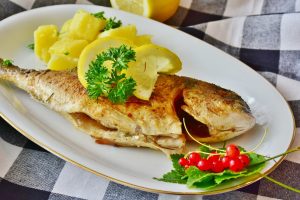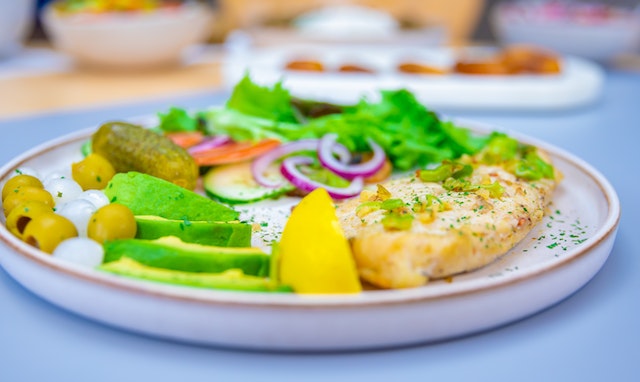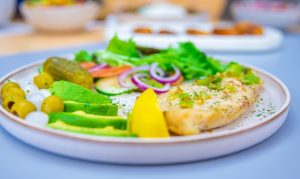The pescatarian diet is a dietary approach that combines the best of both worlds: the health benefits of a plant-based diet with the nutritional advantages of seafood consumption. Pescatarians, who abstain from land-based animal meats but include fish and seafood in their diet, enjoy a seafood-centric lifestyle that offers a wide range of nutritional benefits. In this article, we’ll explore the primary foods that make up the core of a pescatarian diet, emphasizing seafood and plant-based components, and delve into the nutritional advantages of this seafood-centric way of life.
The Core Foods of a Pescatarian Diet
1. Fish and Seafood
Fish: Fatty fish like salmon, mackerel, sardines, and trout are staples in the pescatarian diet. These fish are rich in omega-3 fatty acids, which offer various health benefits, including heart health, brain function, and reduced inflammation.
Seafood: In addition to fish, pescatarians incorporate a variety of seafood, including shrimp, prawns, crab, lobster, clams, and mussels. Seafood provides a diverse range of flavors and textures to pescatarian meals.

2. Plant-Based Foods
Fruits: Pescatarians consume a wide array of fruits, from berries and citrus to tropical fruits like mango and papaya. Fruits are rich in vitamins, antioxidants, and dietary fiber, making them a crucial part of a balanced diet.
Vegetables: Pescatarians prioritize vegetables like leafy greens, cruciferous vegetables, carrots, and bell peppers. These vegetables offer essential vitamins, minerals, and fiber, contributing to overall health and well-being.
Legumes: Legumes such as lentils, chickpeas, and beans are a significant source of plant-based protein for pescatarians. They are also rich in fiber, making them a valuable addition to the diet.
Whole Grains: Whole grains like quinoa, brown rice, and whole wheat pasta are staples in the pescatarian diet, providing sustained energy and dietary fiber.
Nuts and Seeds: Pescatarians often include a variety of nuts and seeds like almonds, walnuts, chia seeds, and flaxseeds. These foods offer healthy fats, protein, and essential nutrients.
Dairy and Eggs (Optional): Some pescatarians choose to include dairy and eggs in their diet. Dairy products like Greek yogurt and cheese provide calcium and protein, while eggs are an excellent source of high-quality protein and essential vitamins.
The Nutritional Benefits of a Seafood-Centric Lifestyle
The pescatarian diet offers numerous nutritional advantages due to its emphasis on both seafood and plant-based components:
1. Omega-3 Fatty Acids
The inclusion of fatty fish and seafood provides an abundant source of omega-3 fatty acids, particularly eicosapentaenoic acid (EPA) and docosahexaenoic acid (DHA). These essential fatty acids play a vital role in heart health, reducing the risk of heart disease, improving cholesterol levels, and reducing inflammation. Additionally, omega-3s are known to support cognitive function and brain health.
2. Lean Protein
Seafood is a lean source of high-quality protein. Protein is essential for building and repairing tissues, supporting immune function, and maintaining muscle mass. For pescatarians, fish and seafood are excellent choices to meet their protein needs.
3. Abundant Nutrients
The plant-based components of the pescatarian diet, including fruits, vegetables, legumes, and whole grains, provide a wealth of essential nutrients. These foods offer vitamins, minerals, antioxidants, and dietary fiber that contribute to overall well-being.
4. Balanced Macronutrients
The pescatarian diet naturally provides a balance of macronutrients. It offers carbohydrates from whole grains and fruits, healthy fats from seafood and plant-based sources, and protein from fish, seafood, legumes, and nuts. This balance supports sustained energy levels and satiety.
5. Flexibility and Sustainability
The pescatarian diet is highly adaptable and sustainable. It accommodates various preferences, allowing individuals to choose whether or not to include dairy and eggs. This adaptability ensures that the diet aligns with personal values and health goals.
Creating Nutrient-Rich Pescatarian Meals
To make the most of the pescatarian diet, it’s essential to focus on nutrient-rich meals. Here are a few ideas for creating balanced, flavorful pescatarian dishes:
- Grilled Salmon Salad: Combine grilled salmon with a variety of leafy greens, cherry tomatoes, cucumbers, and a citrus vinaigrette for a refreshing and nutrient-packed salad.
- Vegetarian Paella with Seafood: Prepare a classic paella with saffron-seasoned rice, bell peppers, peas, and artichokes, adding shrimp, mussels, and squid for a seafood twist.
- Lentil and Spinach Curry: Create a hearty lentil and spinach curry with coconut milk, tomatoes, and a blend of aromatic spices, serving it with brown rice for a complete meal.
- Quinoa-Stuffed Bell Peppers: Stuff bell peppers with a mixture of cooked quinoa, black beans, corn, and diced tomatoes, adding shredded cheese and avocado for extra flavor.
- Greek Yogurt Parfait: Layer Greek yogurt with fresh berries, honey, and a sprinkle of chopped nuts for a satisfying and nutritious dessert or breakfast.
Photo by Vamba Konneh: https://www.pexels.com/photo/close-up-photo-of-cooked-dish-on-white-ceramic-plate-9673813/
In conclusion, the pescatarian diet revolves around seafood and plant-based components, offering a seafood-centric lifestyle with a host of nutritional benefits. This flexible way of eating allows individuals to prioritize their health while enjoying a diverse and flavorful range of foods. Whether you’re looking to improve your heart health, reduce inflammation, or simply savor the flavors of the sea and the earth, the pescatarian diet provides a nutrient-rich path to a well-rounded and balanced way of life.





